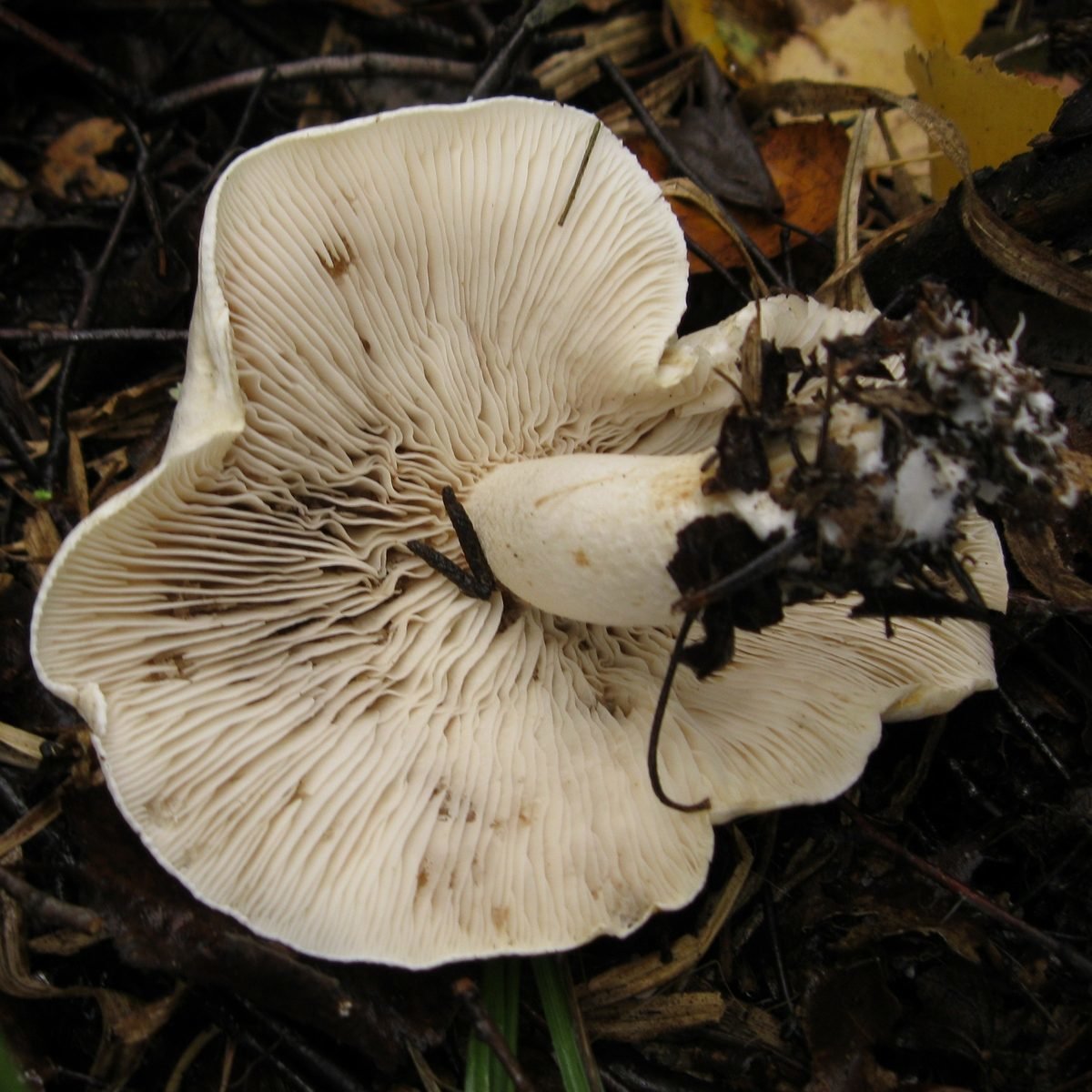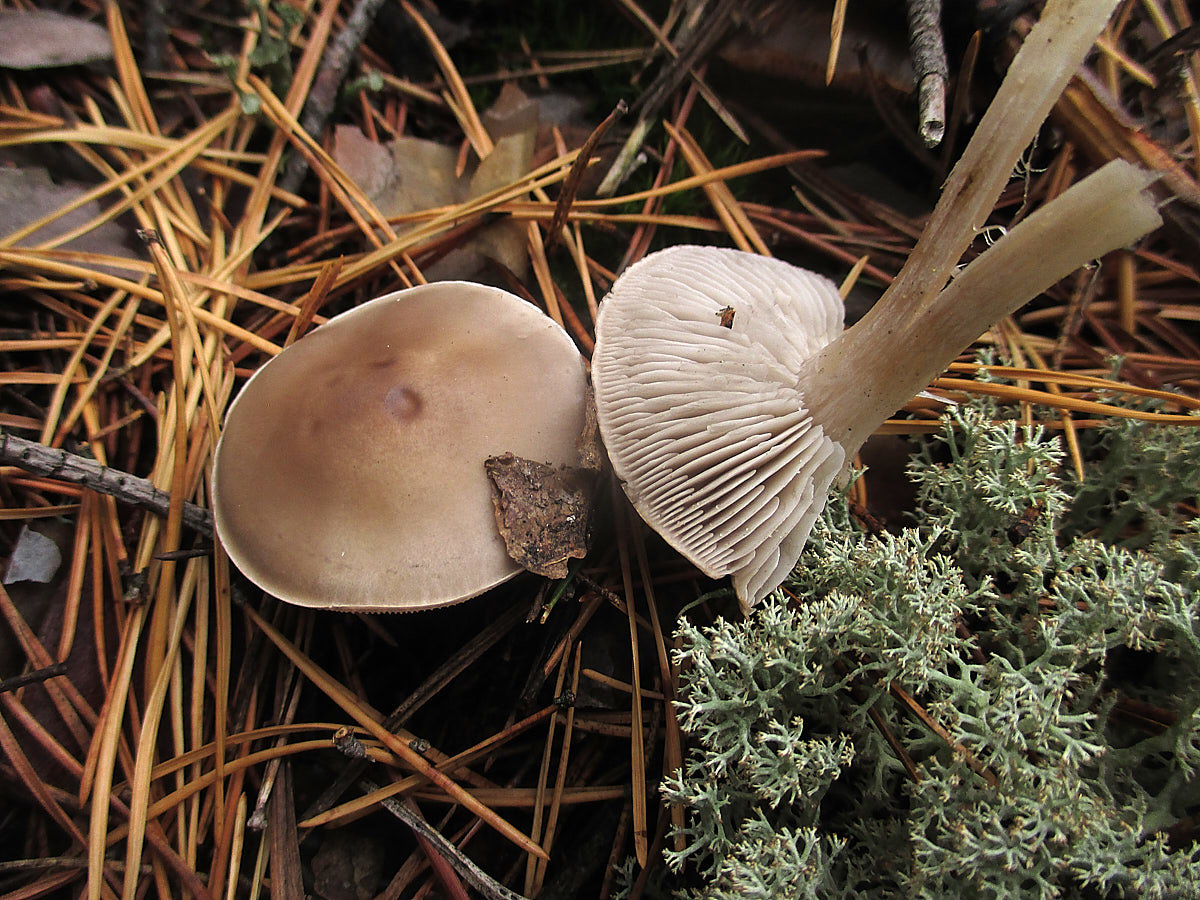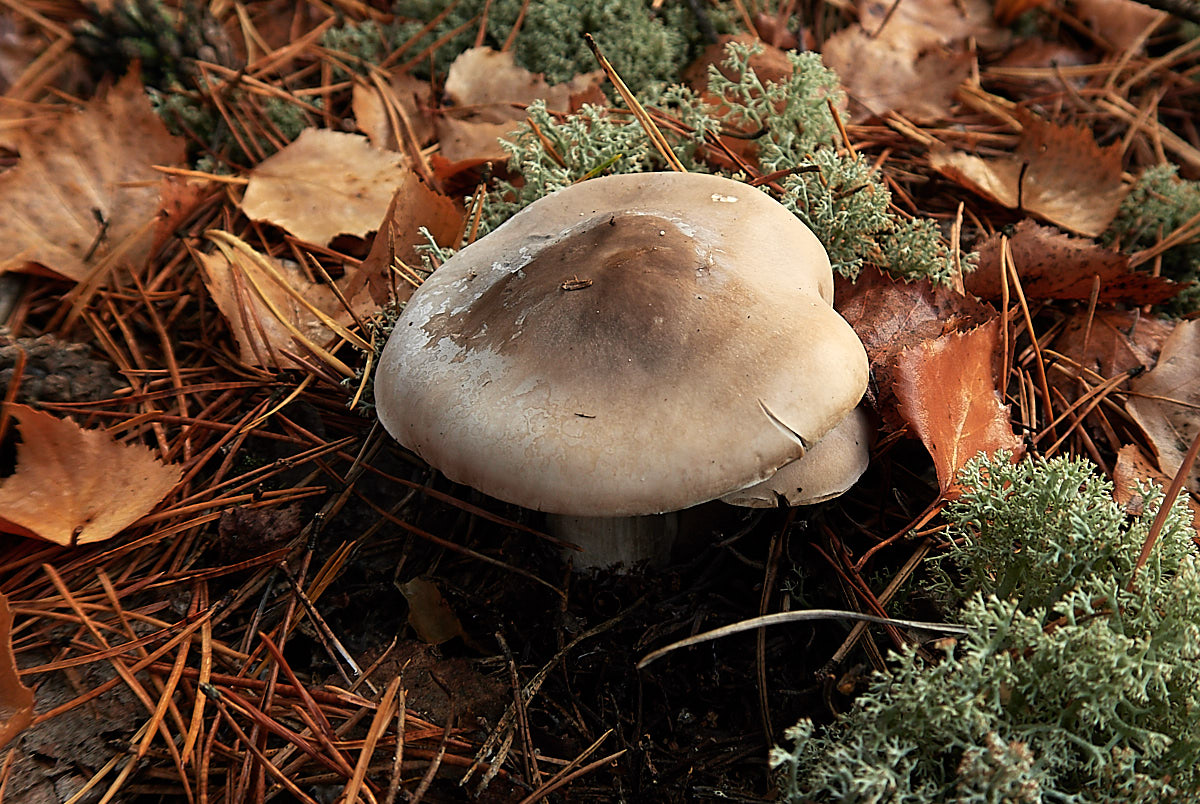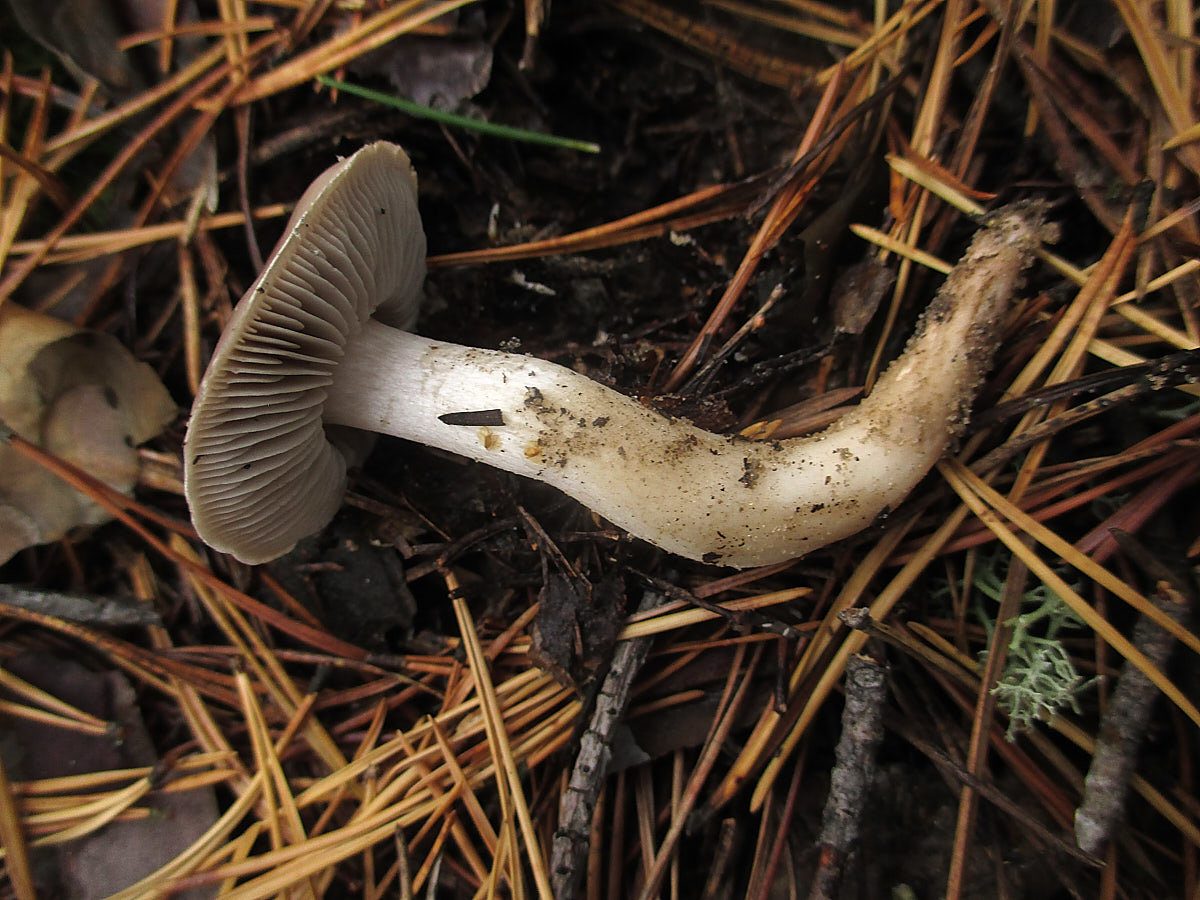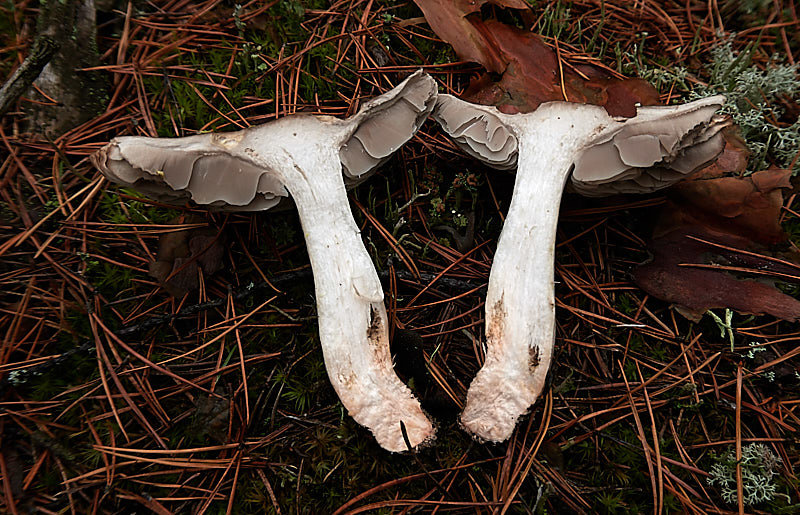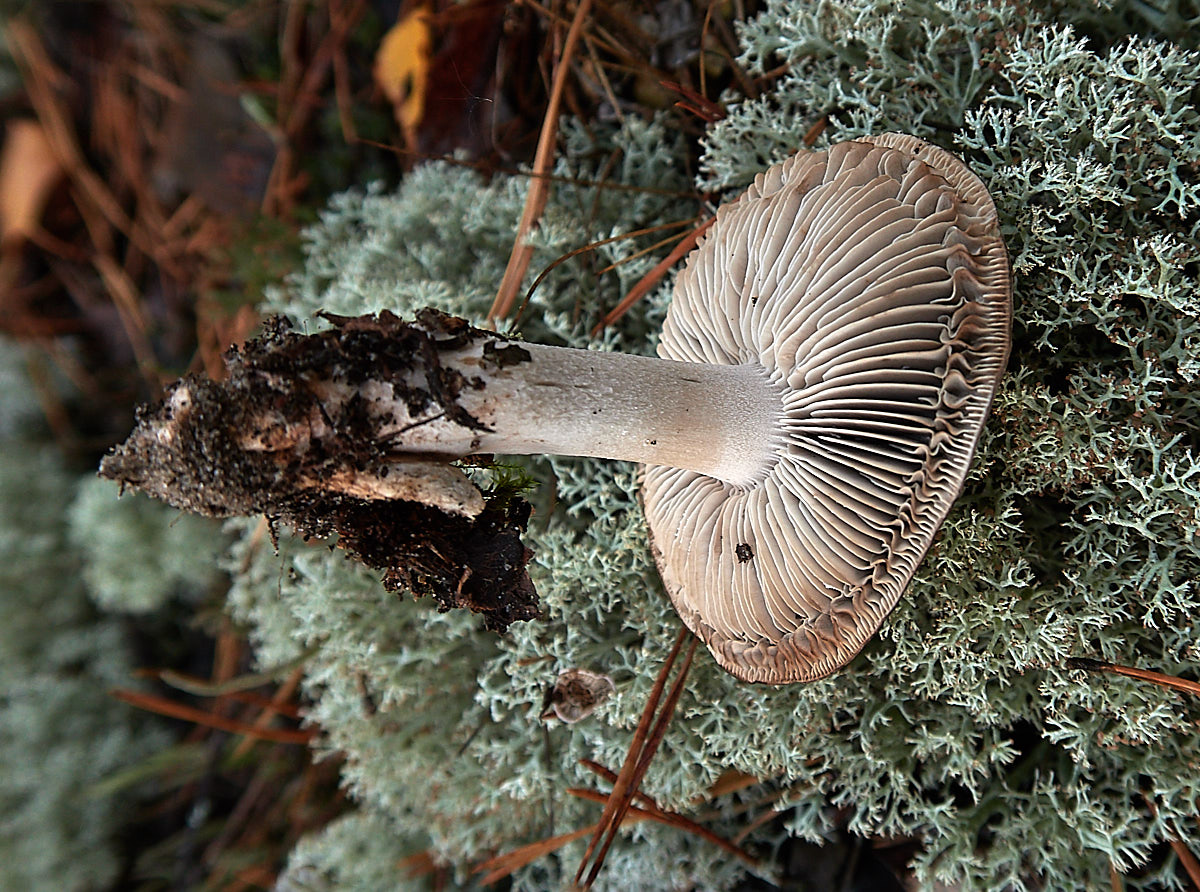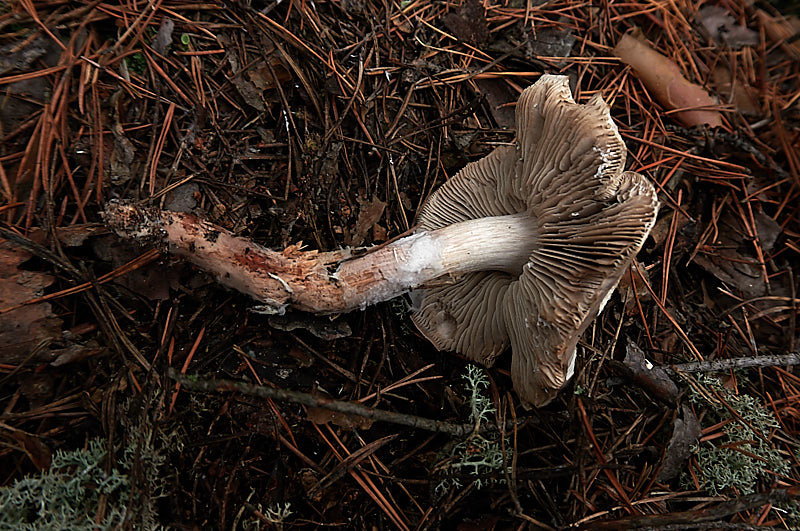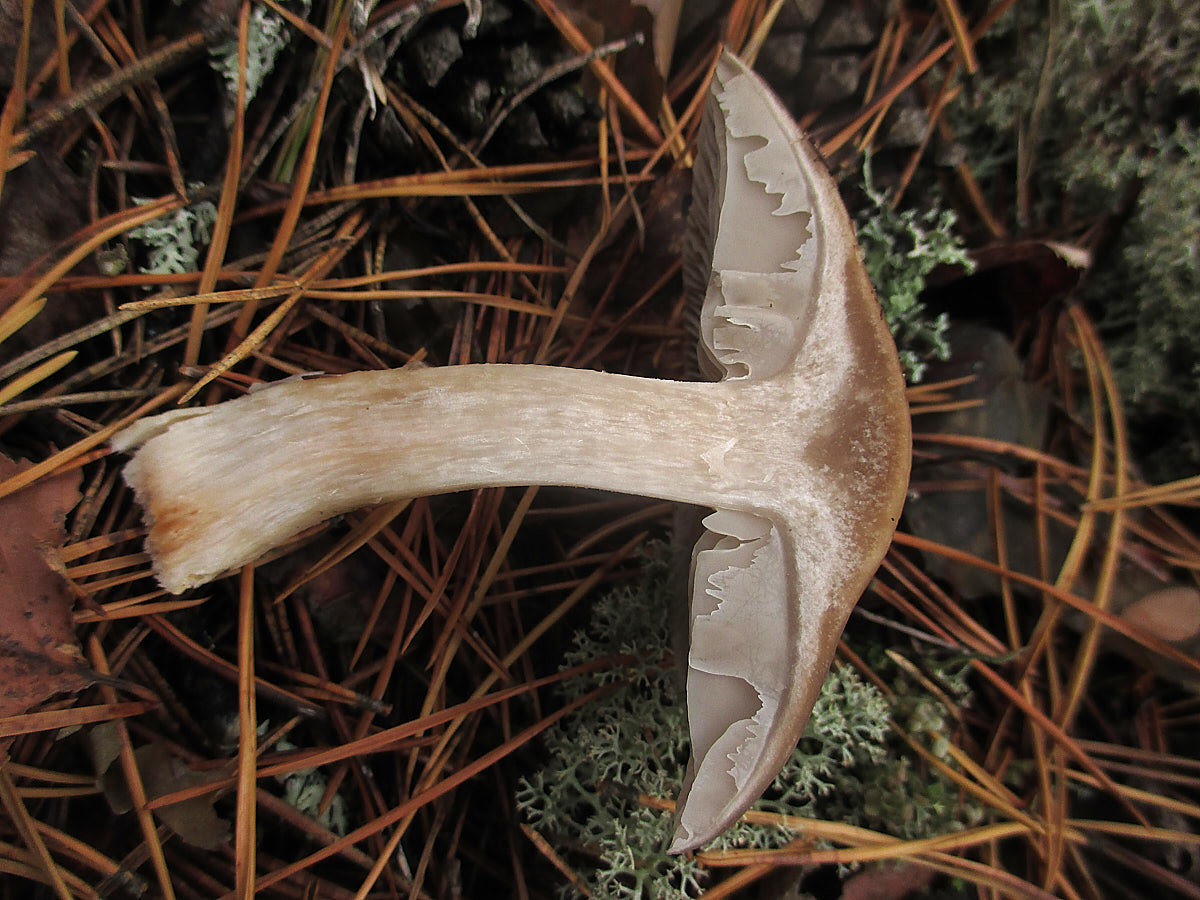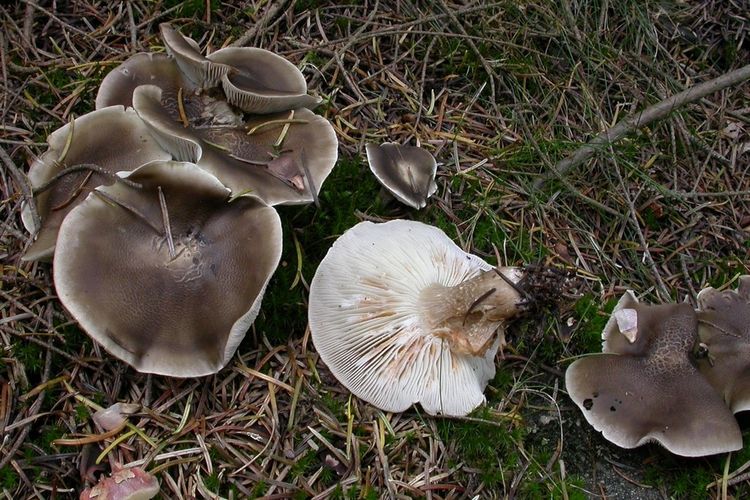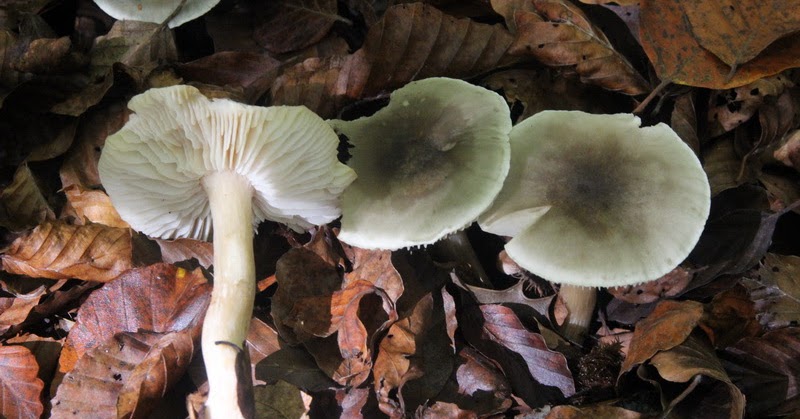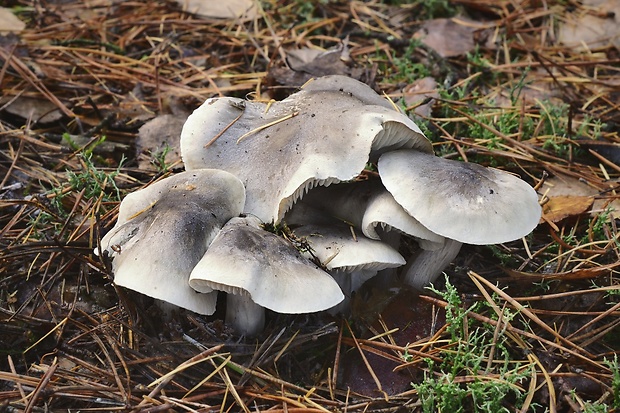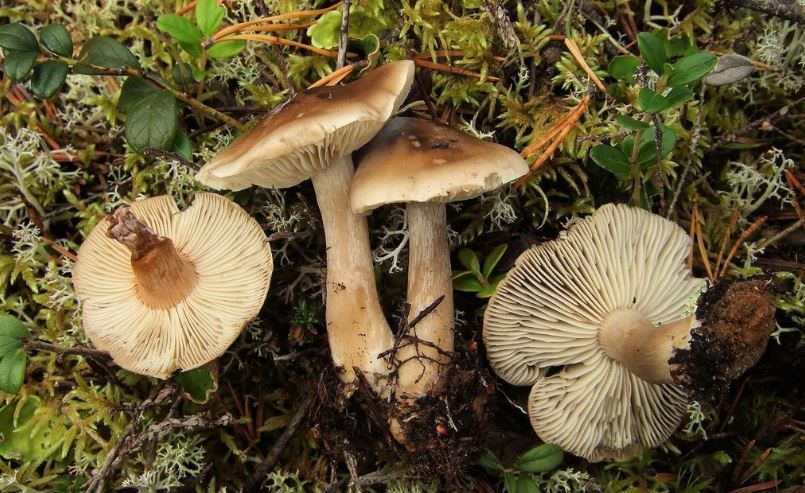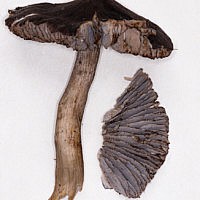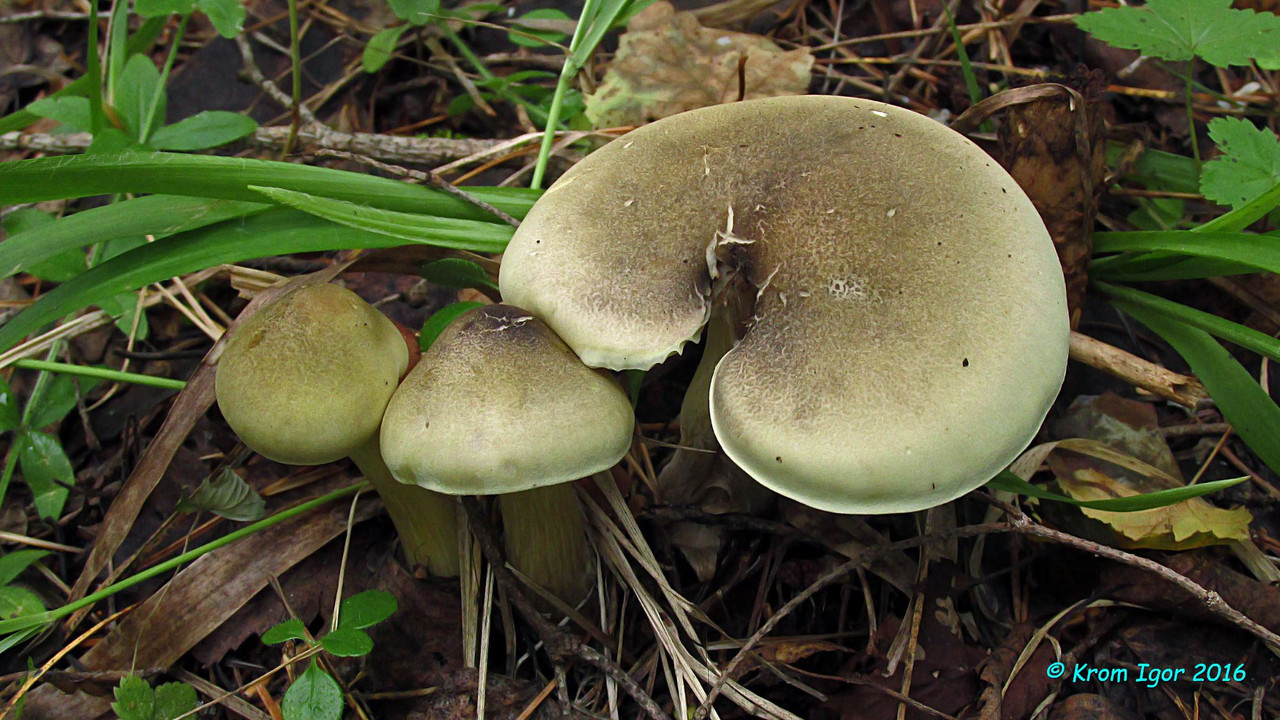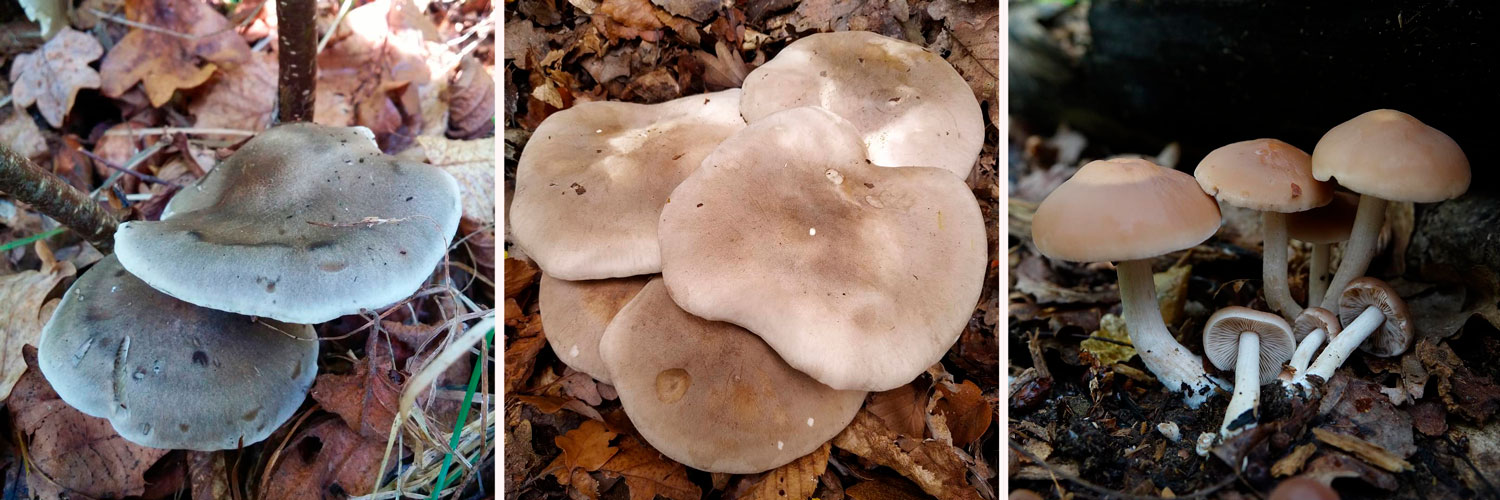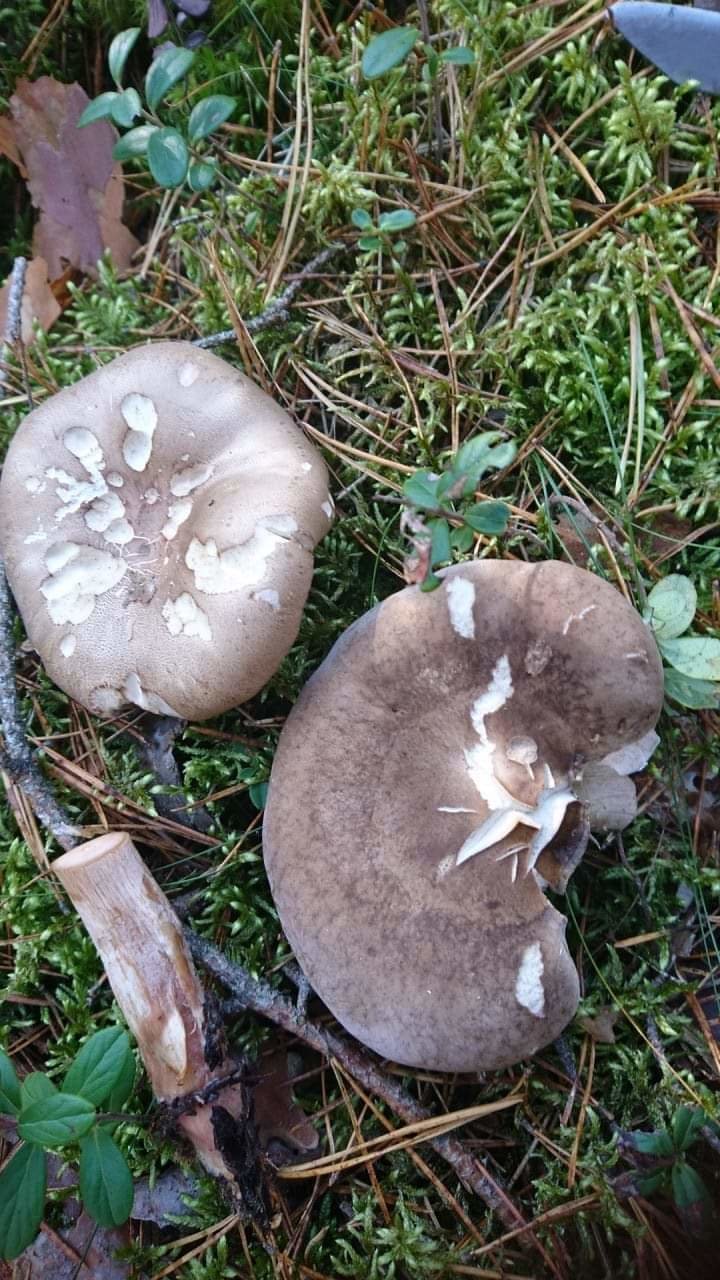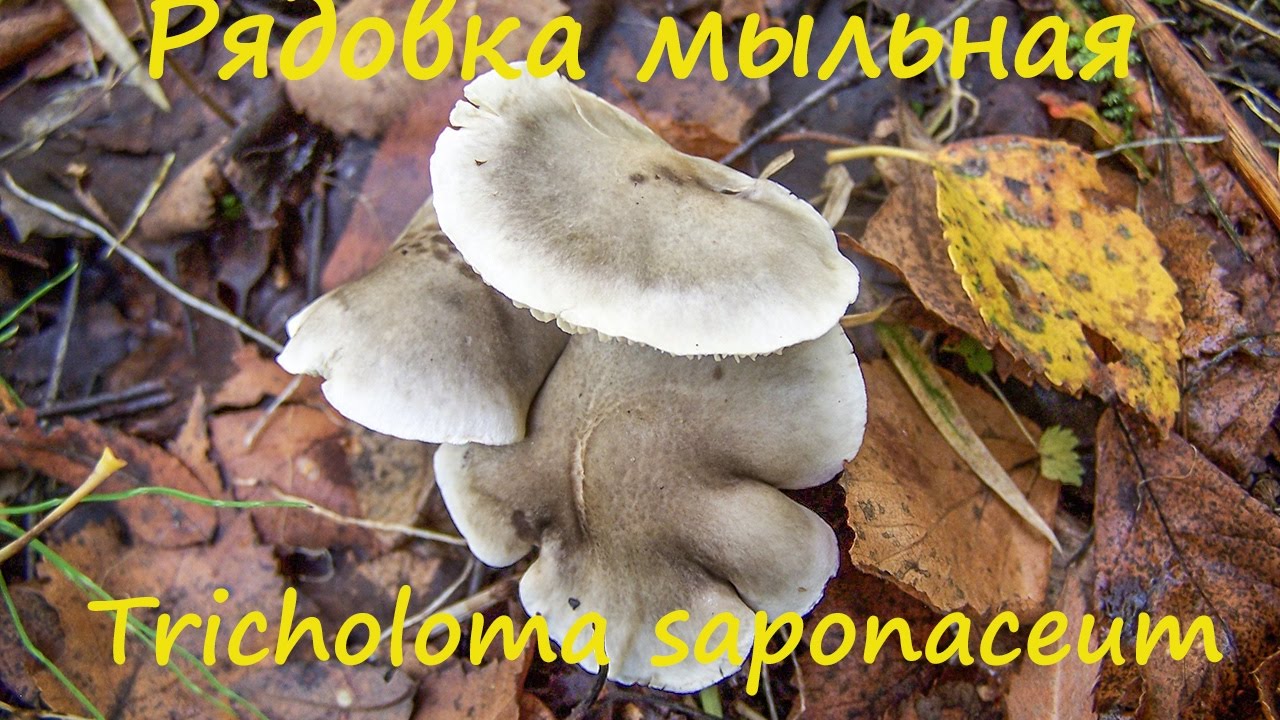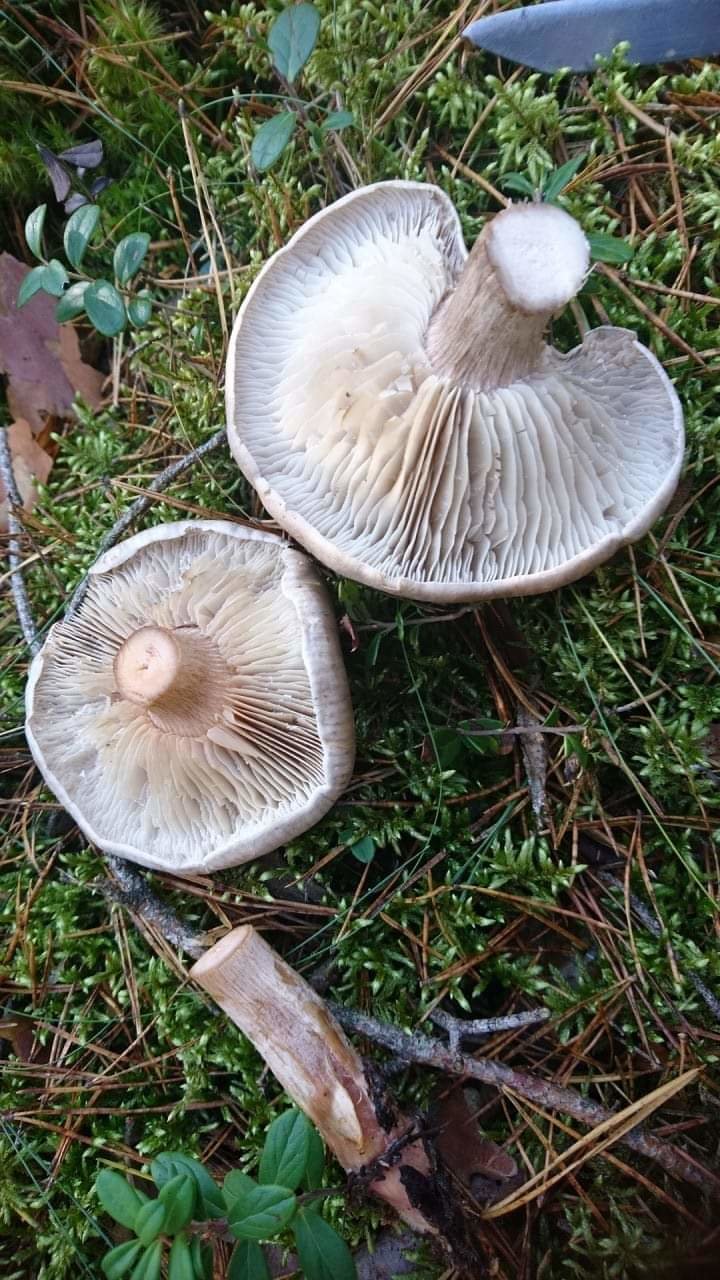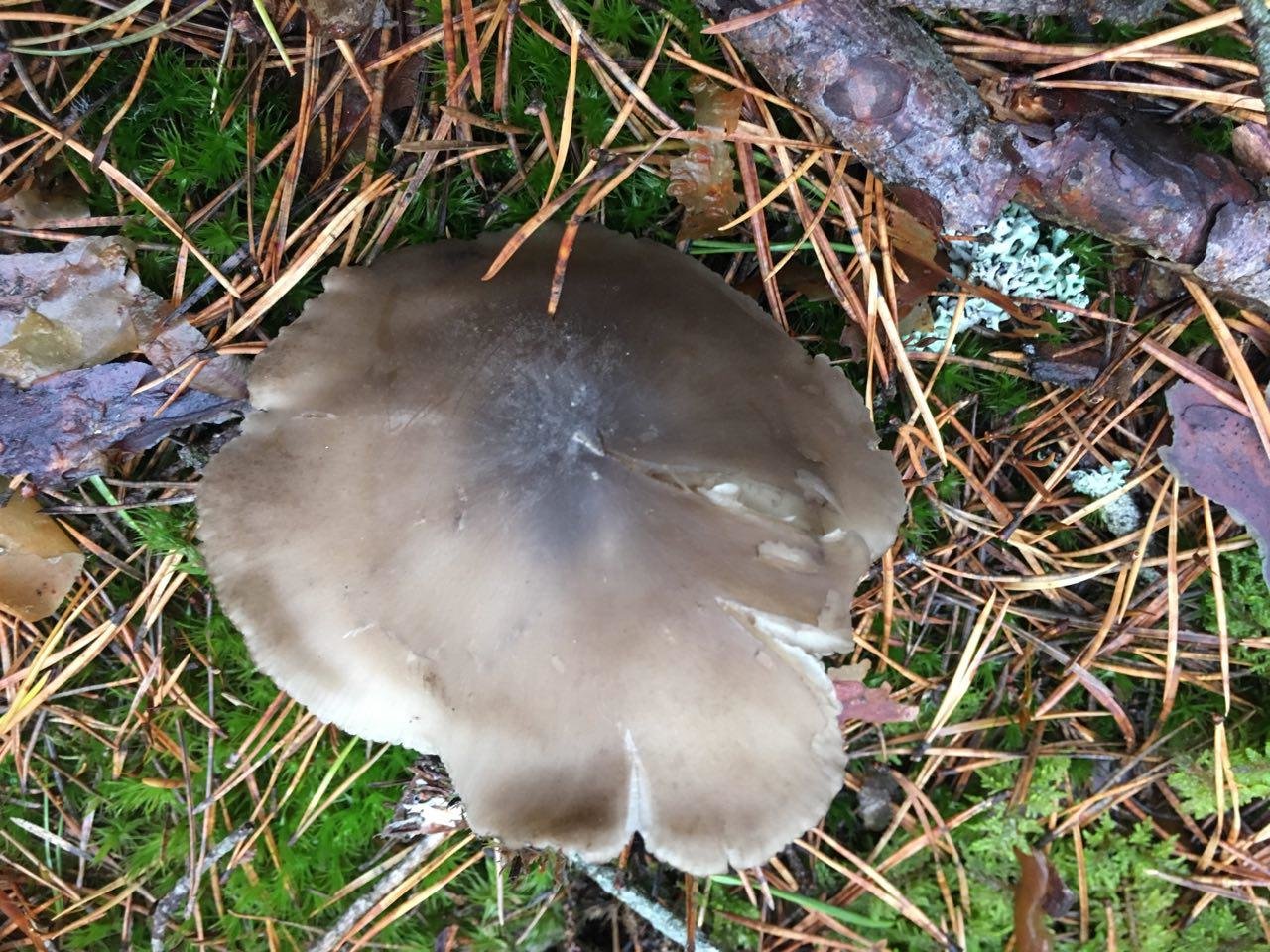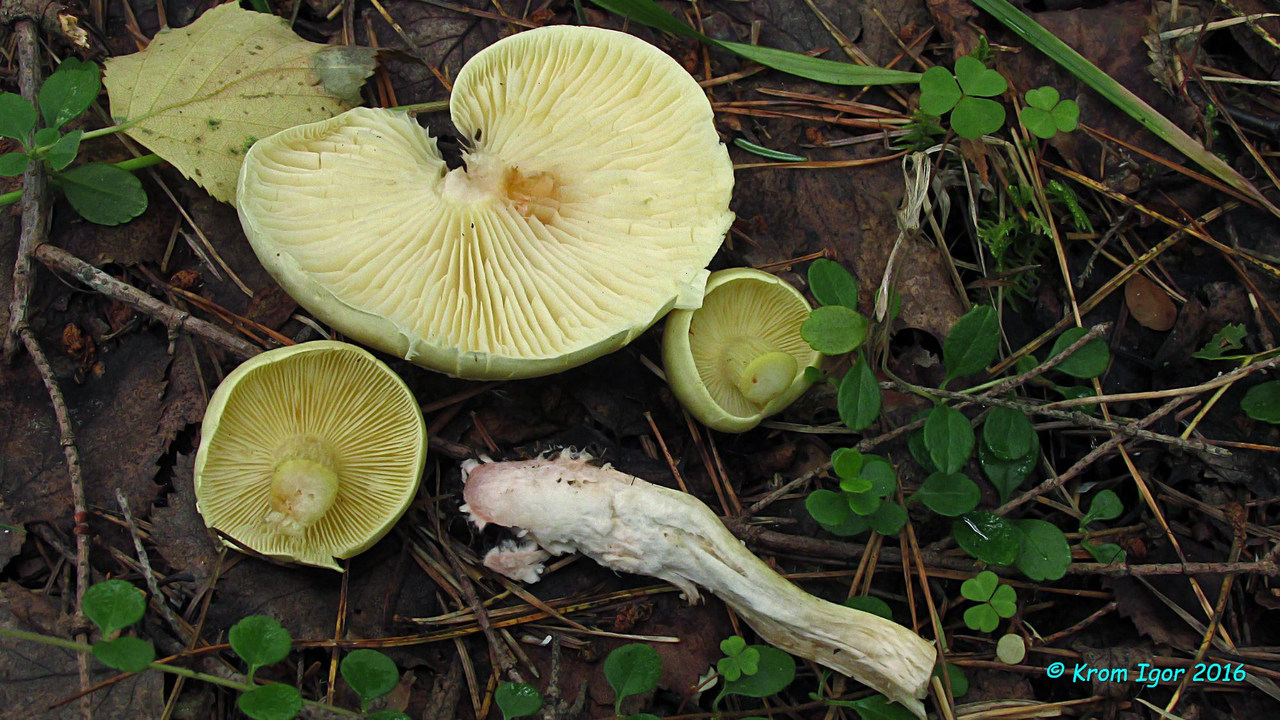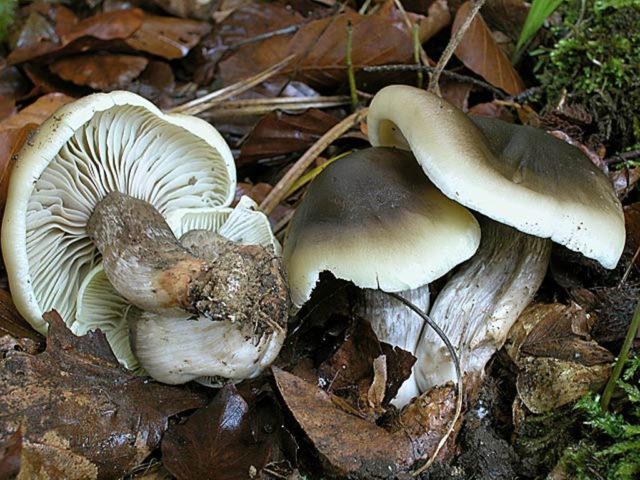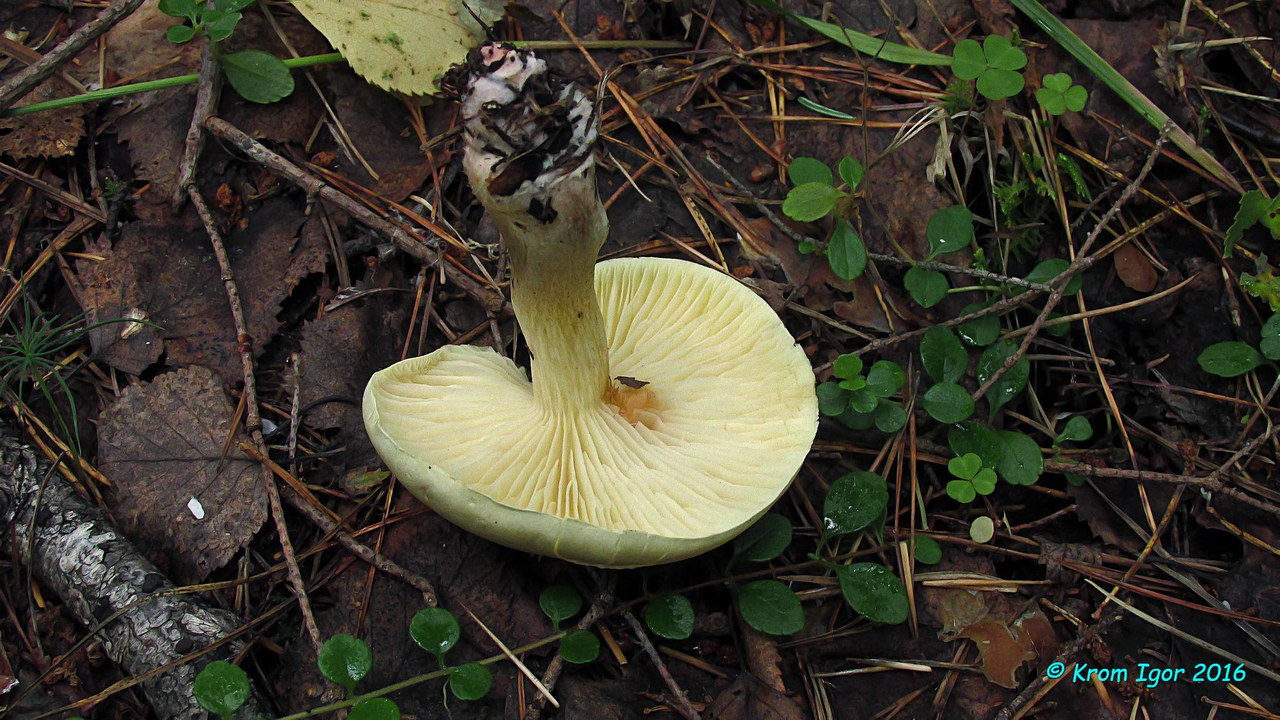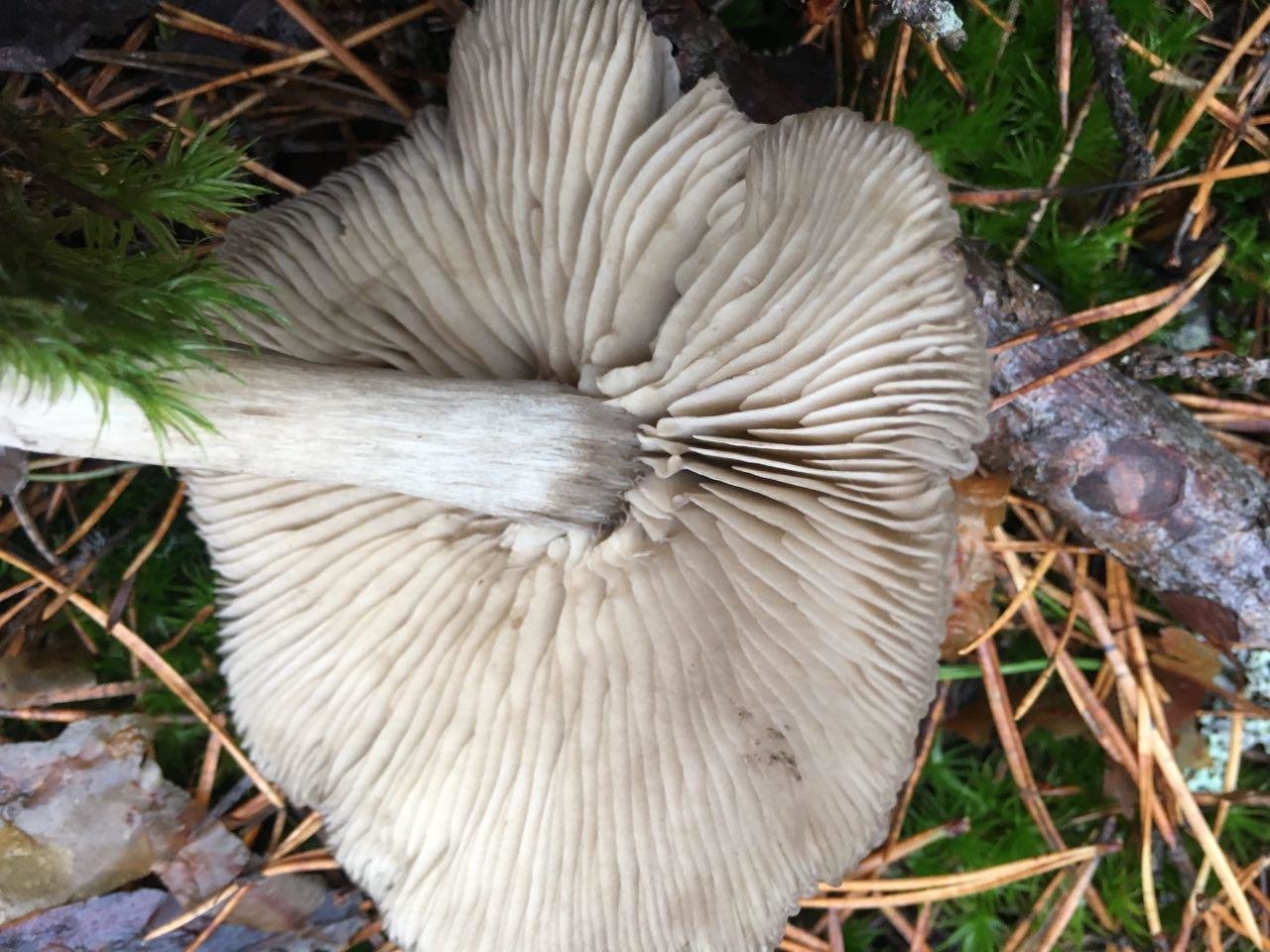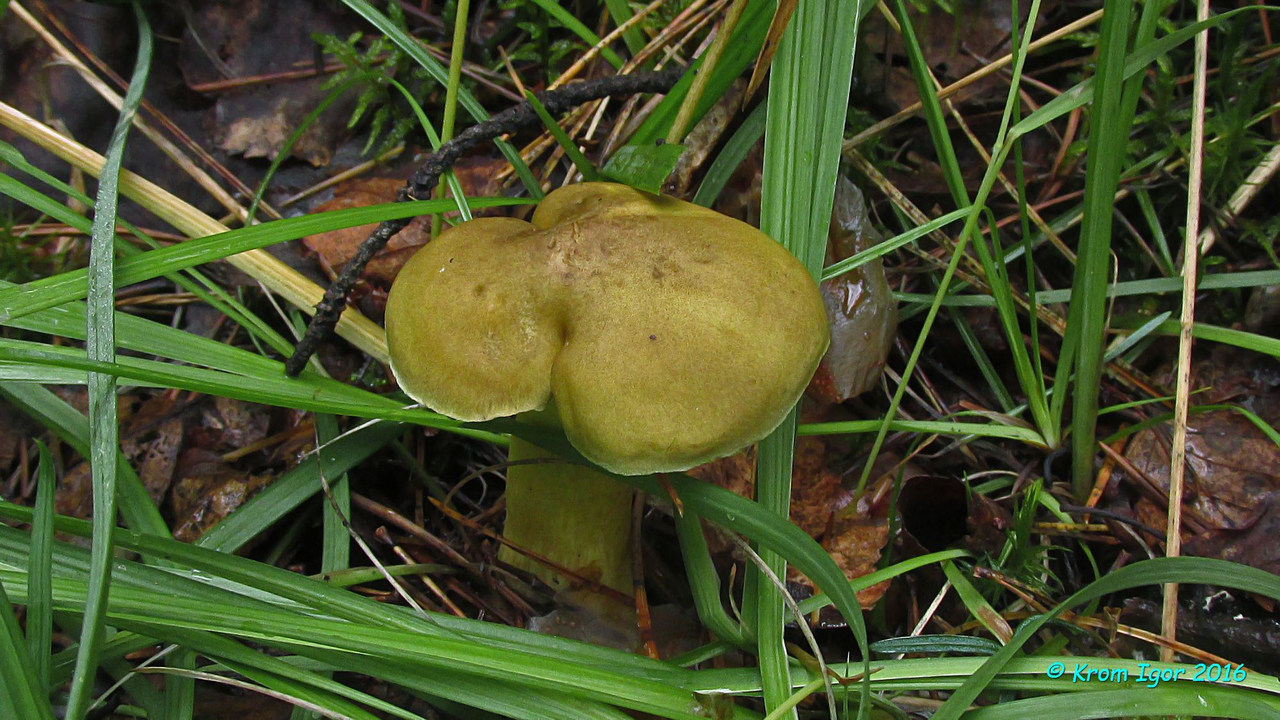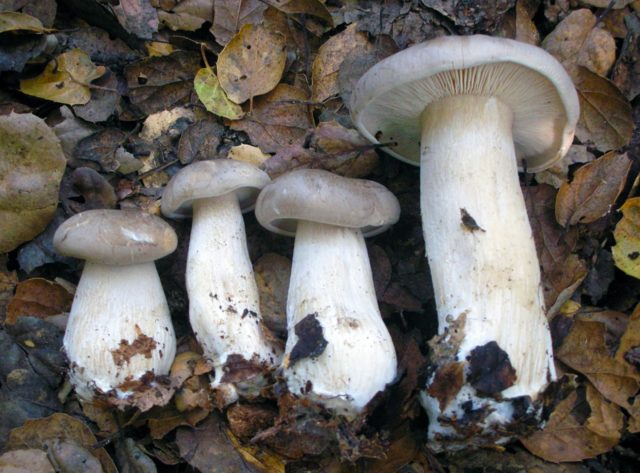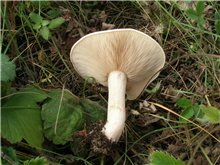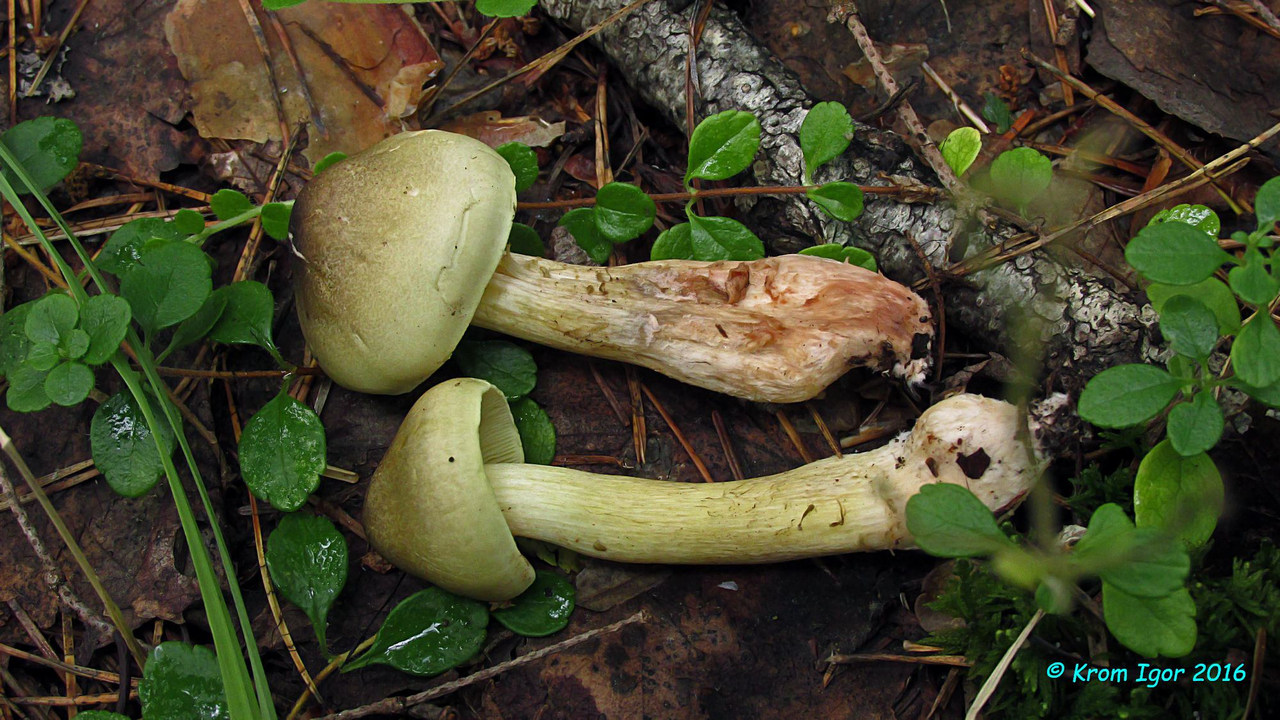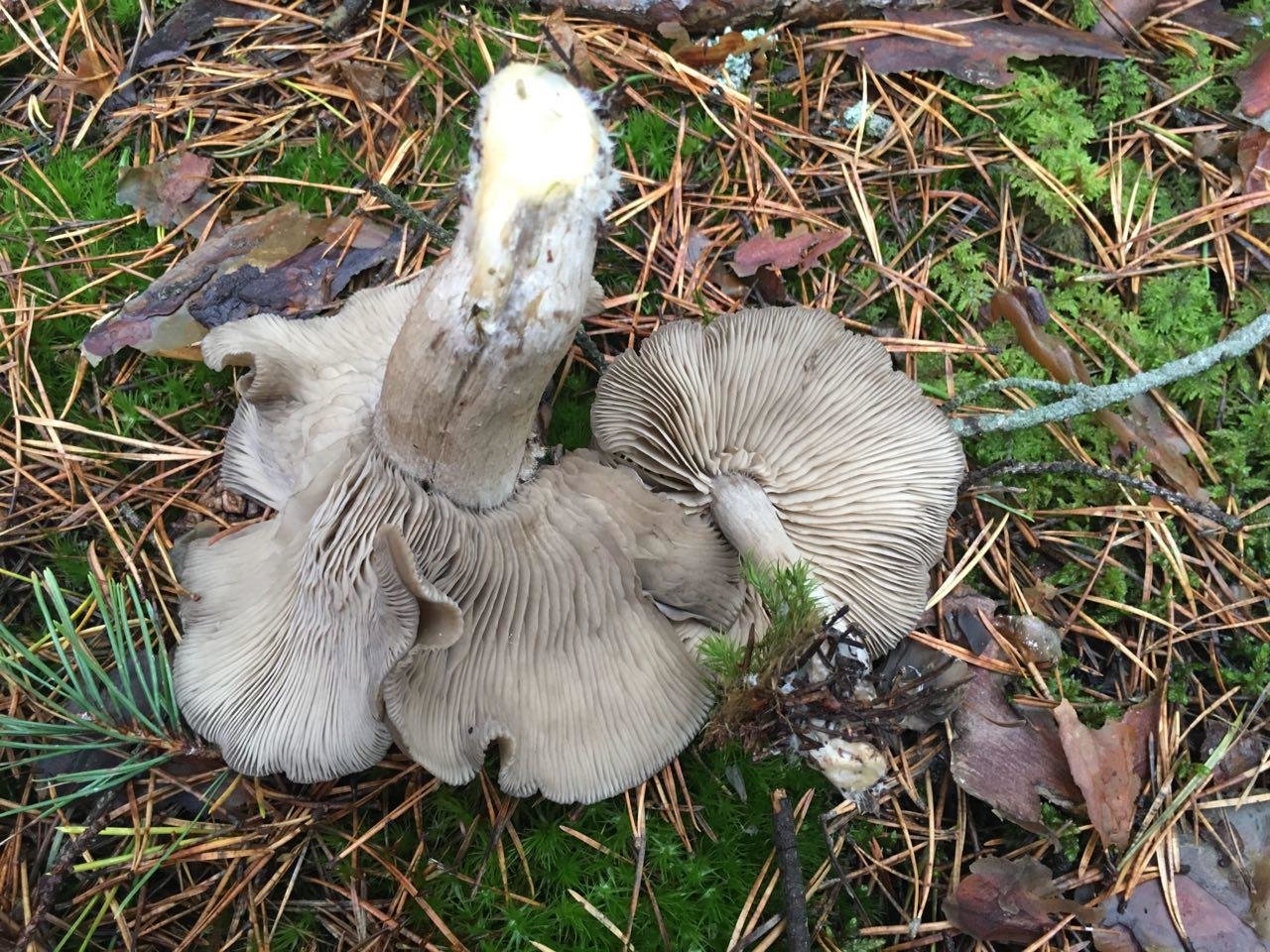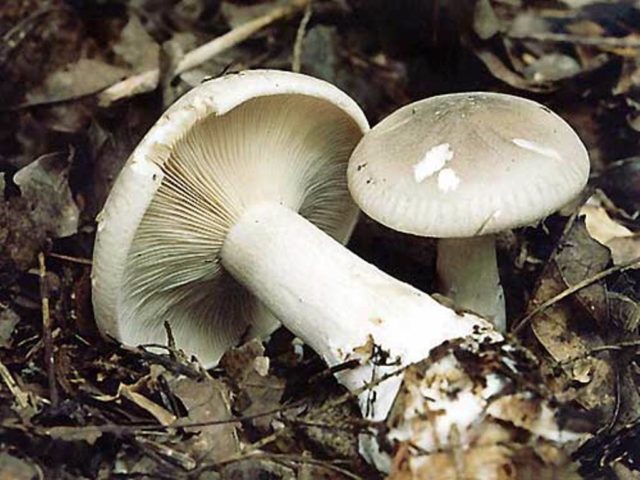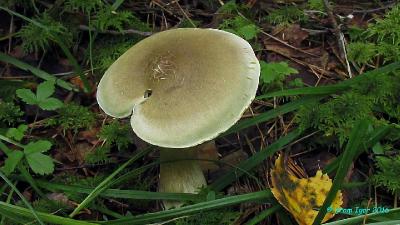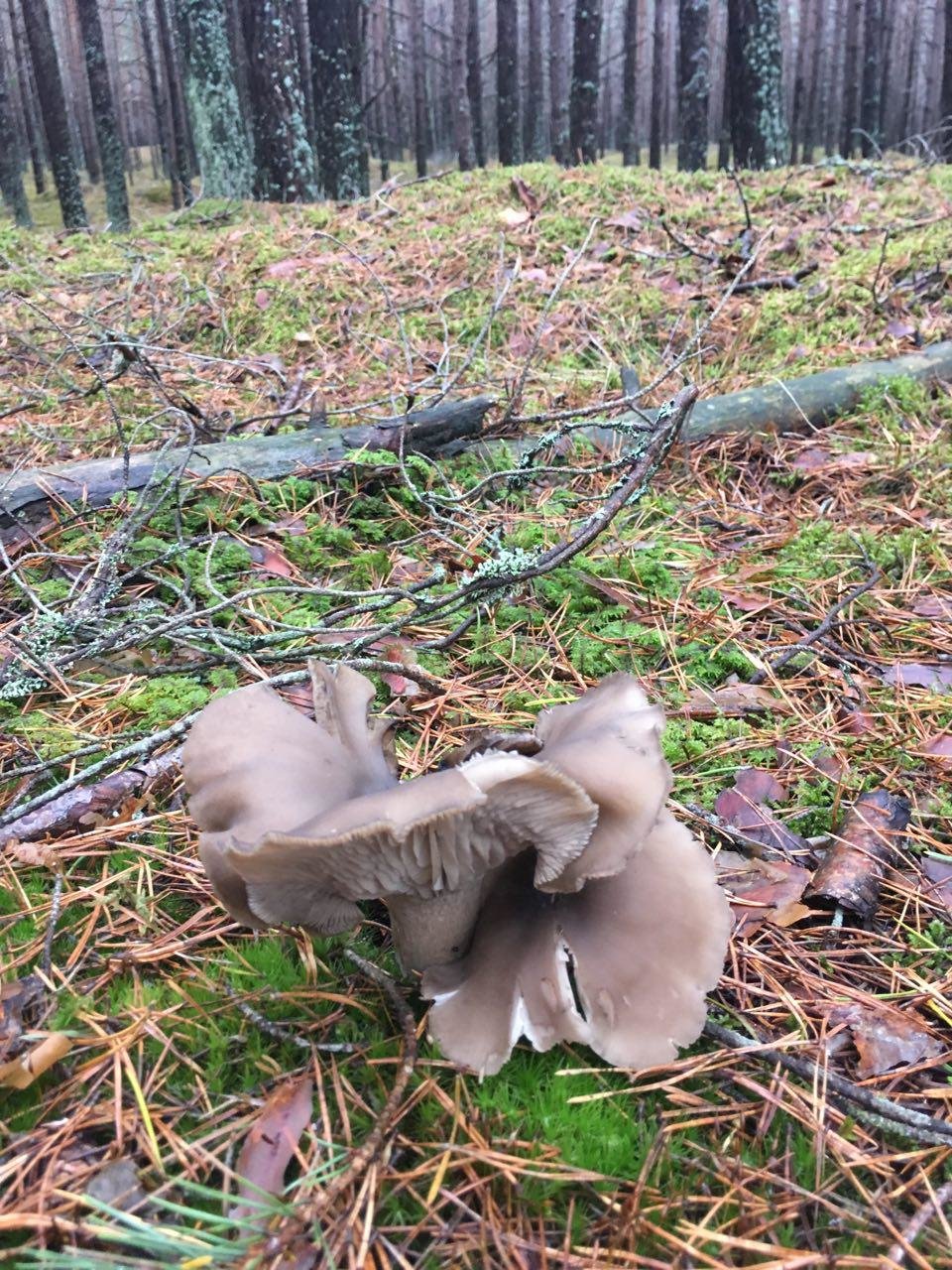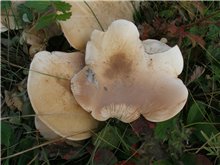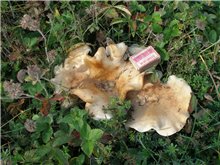Description of the mushroom
The bandaged ryadovka, or red ryadovka, is a member of the family Tricholomotaceae of the genus ryadovka (Tricholoma). Popularly known as the skull.
Latin name Tricholoma focale, scientific synonyms: Tricholoma zelleri, Armillaria zelleri.
Hat with a diameter of up to 12-15 cm, medium fleshiness. Young mushrooms have a convex shape, sticky, yellowish color. Over time, it becomes widespread, dry, with a wavy edge drooping down. The color ranges from scarlet to reddish brown with dark radial stripes. In the center of the cap, scales are sometimes visible on the tubercle.
The hymenophore (the so-called lower part of the cap with a spore-bearing layer) consists of plates adhered to the stem with a tooth. They are located often or rarely, changing color from white and cream to grayish or pale yellow. With age, they become covered with dark brown spots, especially closer to the edges. In young specimens, the plates are hidden under a fibrous sheath (blanket), which disintegrates during growth. The flesh on the cut is dense, thick, white, under the skin it is reddish. Tasteless or slightly bitter, with a faint smell of fresh flour. Spores are wide, elliptical, white powder.
The stem is 4–11 cm long, in some specimens it is 14 cm, up to 4 cm in diameter. Straight, fusiform or tapering towards the base, sometimes curved. In the upper part of the leg there is a fibrous reddish ring, above which the surface is smooth or with a slight whitish flocculent bloom. Under the ring - the color of the cap, in soft felt red-brown scales. Young mushrooms have dense legs, old ones have longitudinal fibers and are hollow.
A bit of history
The mushroom was first described in 1838 by the Swede Elias Magnus Fries. In 1879, the German mycologist Adalbert Ricken gave the species the name Tricholoma focale adopted by modern taxonomy.
Cooking recipes
Cooking
Put a pot of water on the fire and pour in some vinegar. Cook for 10 minutes. Then the liquid is drained, the mushrooms are thrown into a colander and the same procedure is repeated. Rows are boiled in new water with the addition of vinegar for another 20 minutes. A peeled onion will help get rid of the unpleasant odor; it is thrown into the pan 10 minutes before the end of the procedure. Ready mushrooms are washed with cold water.
After that, they can be salted. It is contraindicated to eat in large quantities. This can lead to poisoning.
How to salt a mushroom with garlic and horseradish?

For 5 kg of rows you will need:
- 200 g table salt;
- horseradish leaves (to taste);
- black currant leaves (2 pcs. for each jar);
- cloves of garlic (2-3 for each jar).
Peeled, washed and rid of the soapy odor, mushrooms are placed in sterilized jars. Previously, half of the seasonings and salt are placed in them. Cover the top with the remaining portion of the ingredients. Banks are rolled up and put away in a cool place. The product can be consumed in 45 days.
How to distinguish false mushroom counterparts?
The poisonous white row has a resemblance to Champignon. If you look closely and sniff, you can find such differences: the ryadovka plates do not darken, and the pulp has an unpleasant, pungent smell. While the mushroom hymenophore tends to quickly acquire a brown hue, and the mushroom itself smells good. In addition, the latter has a skirt with a leg and a characteristic veil under the hat.

Champignon
Another "relative" - the stinking ryadovka also has an unpleasant aroma, reminiscent of luminescent gas. It is an organism whose fruiting body contains hallucinogens that can cause the development of both auditory and visual hallucinations. Occurs until late autumn. The differences in the mushrooms can be seen in the photo.
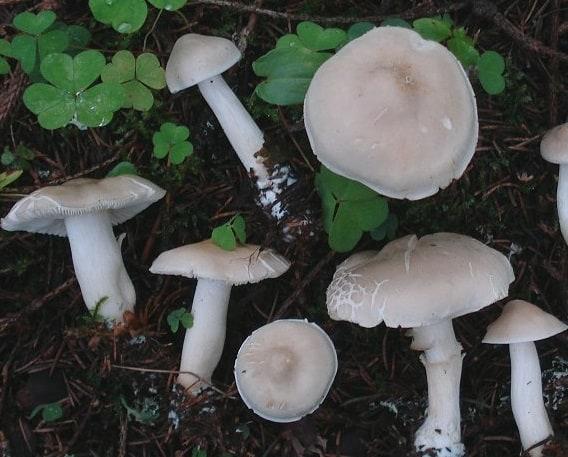
Row smelly
Gray tricholoma is also similar to a row of white, but it grows most often in coniferous forests, has a sticky cap and smells good. The flesh of the gray ryadovka turns yellow at the break, and turns pink in the white one. Inexperienced mushroom pickers often confuse white tricholoma with porcini mushroom, a talker.

Row gray
Difference from White Gruzdya
There are obvious differences between a load and a row. The cap of the first has a funnel-shaped shape, there is a small fringe at the edges, while in the tricholoma this part is flat, with a slightly wavy edge. In addition, these parts also differ to the touch, if a real lump is sticky, sticky, then the row is dry, smooth. The structure of the pulp is also different: it is fibrous in the tricholoma, while in the edible species it is strong and juicy. Sizes of the leg: the milk mushroom practically does not have this part of the fruiting body, or it is very small, in the row it reaches 5–10 cm. The smell is also different, the tricholoma smells unpleasant, has a sharp, radish aroma.
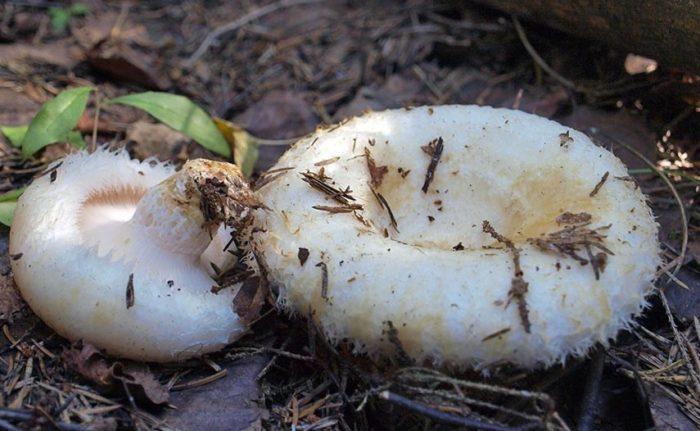
White lump
Use in cosmetology
Cosmetology today is experiencing a mushroom boom. Japanese truffles were not aloof either; they are actively used in the beauty industry. One of the products containing matsutake extract, for example, is the "Guru of Radiance" mask, which is used for adult skin. With the constant use of cosmetics based on a shoe row, the following effect is observed: a unique composition removes wrinkles, unwanted skin pigmentation, makes the skin light and fresh.
Pine mushroom face mask
Matsutake mushroom extract is used for her. Eastern cosmetology believes that it provides unfading youth, removes free radicals from the body, and inhibits the aging process of the skin. Ready-made fabric-based masks are easy to purchase from specialized or online stores. You need to use them as follows:
- Wipe the skin with lotion.
- Apply the mask to the face and smooth it out.
- Leave it on the skin for 5-15 minutes.
- Then remove, with patting movements distribute the essence evenly, let it absorb.
It is recommended to make such masks 2 times a week.
Poisoning signs and first aid
Some mycological scientists consider this mushroom conditionally edible, even suggest using it in the form of pickles. But in a twin similar to it, green tea, poisonous substances were found that are capable of destroying muscle fibers. Therefore, this mushroom, as a related one, is not recommended to eat due to similar properties.
If unpleasant symptoms appear after eating mushrooms, you should immediately call an ambulance and start taking preliminary measures:
- Rinse the stomach immediately to remove fungal particles and toxins. A potassium permanganate solution is suitable for this. The slightly pink liquid should be drunk as much as possible, in small sips. You can also prepare a saline solution (half a teaspoon of salt per liter of water).
- Induce vomiting until the stomach contents are clear.
- Take a double dose of adsorbents: Enterosgel, Polysorb, Filtrum, activated carbon.
- Put the victim to bed, wrap up with a blanket and apply a heating pad.
- Constantly drink sweet tea, still mineral water, chamomile decoction.
Silver row (Tricholoma scalpturatum)
- Other names for the mushroom:
- Row yellowing
- Carved row
Other names:
- The row is yellowing;
- The row is carved.
Row silver (Tricholoma scalpturatum) is a mushroom belonging to the Tricholomov family, the Agarikov class.
External description
The fruiting body of the silvery row consists of a cap and a leg. The diameter of the cap varies within 3-8 cm, in young mushrooms it has a convex shape, and in mature mushrooms it is prostrate, with a tubercle in the central part. Sometimes it can be concave. In ripe mushrooms, the edges of the cap are wavy, bent, and often torn. The fruit body is covered with a skin with the finest fibers or small scales pressed to the surface.this skin is more often gray in color, but it can be gray-brownish-yellow or silvery-brownish. In overripe fruit bodies, the surface is often covered with specks of lemon-yellow color.
The fungal hymenophore is lamellar, its constituent particles are plates, they grow together with a tooth, often located in relation to each other. In young fruit bodies, the plates are white, and in ripe ones, they turn yellow in the direction from the edges to the central part. Often, on the plates of overripe fruit bodies of a silvery row, you can see yellowish spots, unevenly distributed over the surface.
The height of the stalk at the silvery row varies within 4-6 cm, and the diameter of the mushroom stalk is 0.5-0.7 cm.It is silky to the touch, thin fibers are visible to the naked eye. The shape of the stem of the described mushroom is cylindrical, and sometimes small pieces of skin are visible on its surface, which are the remains of a common blanket. In color, this part of the fruiting body is gray or whitish.
The structure of the mushroom is very thin, fragile, with a powdery color and aroma.
Season and habitat of the mushroom
Row silver grows in forests of various types. Often, this type of mushroom can be found in the middle of parks, squares, gardens, forest shelter belts, along roadsides, in grassy areas. You can see the described mushroom as part of large groups, since the scaly row often forms the so-called witch's circles (when whole colonies of mushrooms are connected to each other in large bundles). The fungus prefers to grow on calcareous soils. On the territory of Russia and, in particular, the Moscow region, the fruiting of silvery rows begins in June and continues until the second half of autumn. In the southern regions of the country, this mushroom begins to bear fruit in May, and the duration (during warm winters) is about six months (until December).
Edibility
The taste of the silvery ryadovka is mediocre; this mushroom is recommended to be eaten salted, pickled or fresh. It is advisable to boil the silvery ryadovka before eating, and drain the broth. It is interesting that when this type of mushroom is pickled, their fruit bodies change their color, becoming green-yellow.
Similar types and differences from them
Often, another type of mushroom, Tricholoma imbricatum, is called a silvery (scaly) row. However, both of these ryadovki belong to completely different categories of mushrooms. The silvery ryadovka described by us is similar in its external features to earthy ryadovka, as well as to above-soil tricholom mushrooms. Very often these types of mushrooms grow in the same place, at the same time. It also looks like a poisonous tiger row.
Time and place of picking wild pine mushrooms
Translated from Japanese "matsutake" means "pine mushroom", which indicates the peculiarity of the growth of the species. It lives in forests at the foot of the roots of red pines on moss or fallen needles. Grows in groups, often forming rings around trees. Prefers old groves, 40-60 years old.
Pine ryadovka is ascetic, but also picky about the conditions of existence: it loves barren, dry soil. Under the mycelium, the soil becomes whitish.
Places of distribution - pine forests of Japan, Korea, China, Finland, Sweden, North America. In Russia, it grows in the Urals, in the Primorsky Territory, now it is recorded in the Red Book of Primorye. Sometimes found in Belarus and Ukraine.
Fruiting under favorable weather conditions begins in August and can continue until November. The depth of the spotted row into the soil layer and forest flooring allows it to easily endure autumn frosts. But the most active period of growth and collection of mushrooms is September - October.


